Data collection, display, and analysis
By Mary Bigelow
Posted on 2009-03-22
 Cockroaches, fast food, roadkill, rainfall—the articles in this issue of Science Scope show that middle level science students and teachers can use inquiry skills in studying almost any topic. Collecting, organizing, and analyzing data are important components of inquiry activities and these articles have great teacher-tested examples of how students can organize their observations and findings.
Cockroaches, fast food, roadkill, rainfall—the articles in this issue of Science Scope show that middle level science students and teachers can use inquiry skills in studying almost any topic. Collecting, organizing, and analyzing data are important components of inquiry activities and these articles have great teacher-tested examples of how students can organize their observations and findings.
The article Chow Down describes studying the diets of Madagascar hissing cockroaches. I’ve been in classrooms that had these interesting insects, but most students didn’t go beyond the “Ewww” or “Oh Wow” observations. This article has some great ideas and resources for ongoing inquiry activities. These can be supplemented through the SciLinks topic Insects. I especially like Bugs from Museum Victoria in Australia. (I used to get concerned about the use of the word “bugs” until I worked on a project with a research entomologist who used the term all of the time!)
To supplement Big Macs and Healthy Teens? check out Calorie Count (if you don’t mind a few ads). This searchable site has nutritional information on individual food items as well as on menu items from fast food and chain restaurants.
OK, so your state does not have the roadkill records that the students in Roadkill Data Analysis could access. You could replicate this type of investigation with other data sources such as eBird. SciLinks can provide additional data resources, with websites on a variety of topics such as Collecting Weather Data and Presenting Scientific Data. One of my favorite online tools is Create a Graph from the National Center for Education Statistics.
Let’s not forget that we collect data in order to answer questions. The article A Land-Use-Planning Simulation Using Google Earth shows how students investigate questions with state-of-the-art data, and the simulation could be customized for anywhere. Record Keeping in Science was the theme of the January 2009 issue of Science Scope. Some of the ideas in this journal may also be appropriate or adaptable for older students.
 Cockroaches, fast food, roadkill, rainfall—the articles in this issue of Science Scope show that middle level science students and teachers can use inquiry skills in studying almost any topic.
Cockroaches, fast food, roadkill, rainfall—the articles in this issue of Science Scope show that middle level science students and teachers can use inquiry skills in studying almost any topic.
Using tools to move water: observing children's creative problem solving
By Peggy Ashbrook
Posted on 2009-03-22
I’m looking for ideas on how children can move water in different ways outdoors when the weather warms up. Ideally we’d have a shallow, slow-moving stream of pristine water nearby….
 Indoor water exploration, in small amounts in containers, develops problem-solving skills in children. They think it is wonderful to move water from one container to another. They eagerly took up this challenge and stayed focused on the task for 45 minutes. The objective was to explore the idea of “work” as expending energy to move water, to raise the question of what force(s) move water, and to give the children a few problems to solve. Each child had two containers and the task was to move water from one to the other. I demonstrated using a spoon to move the water and then moved around the table adding a drop of food coloring to the water in each container to make it easier to see. (The food color slowly diffuses into water unless the children mix it—another cool thing to observe and wonder about.)
Indoor water exploration, in small amounts in containers, develops problem-solving skills in children. They think it is wonderful to move water from one container to another. They eagerly took up this challenge and stayed focused on the task for 45 minutes. The objective was to explore the idea of “work” as expending energy to move water, to raise the question of what force(s) move water, and to give the children a few problems to solve. Each child had two containers and the task was to move water from one to the other. I demonstrated using a spoon to move the water and then moved around the table adding a drop of food coloring to the water in each container to make it easier to see. (The food color slowly diffuses into water unless the children mix it—another cool thing to observe and wonder about.)
Some interesting problem solving was seen during this activity. Children who have the tall quart carryout containers complained that the spoon could not hold much water, that the task was taking too long. The containers are too narrow to hold the spoon completely level so only a few drops stay in the spoon. Many children decided to solve the problem by picking up the containers and pouring the water into the second container. Most did this without asking permission or looking at the teacher, but several of the children who frequently need to be redirected from disruptive behavior looked up at the teachers as they did this, a look I interpret as meaning they thought they might be doing something wrong. Another child at the table felt the need to alert me to their neighbor’s pouring behavior, expecting me to correct it! I assured all that it was okay to pour the water, and even a good problem solving idea. At first the children approached the task seriously and sedately. As they switched seats to try different container sets conversation developed with the teachers’ prompts of “How is this container set different from the first set you used?”
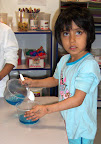

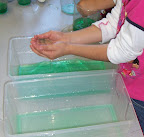.jpg)
While the children are engaged in the work of moving water I make comments about how scientists do work and sometimes have to change their equipment to make the work easier. During the hour I offer to trade tools with the children, showing first some laundry and baby formula scoops, and later, eye droppers and pipettes, baby nasal aspirators, syringe/irrigators, and pumps from liquid soap containers (supported with a surrounding clear plastic tube). The conversation expands along with the variety of tools.
As the children work, the teachers ask how they get the water to move, what tool is working “best,” and what is “pulling” the water down into the container from the spoon. The children demonstrate how they lift the water, or push and pull, or squeeze and release, the tools. Teachers introduce the word “force” and ask, “Which tool requires the most force to use? Which tool do you have to use the most muscles to move?”
The large laundry scoop is often seen as the best tool by all the children at first, but those at the tall container stations discard it in favor of droppers as the water level gets near the bottom. Children with poor motor skills do not favor the pumps which need two hands to secure and operate.
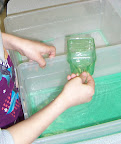.jpg)
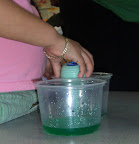
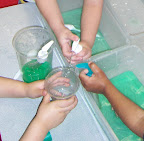.jpg)
The activity ended with a group recording session, marking tallies on a chart to show which tool they liked the best. A second chart was marked to show which tool the children thought moved the “most” water. Some children choose the tool that moved the largest amount of water at one time, others picked the tool that seemed to move water the fastest, and of course some just chose the empty section on the chart or the same section their friend picked.
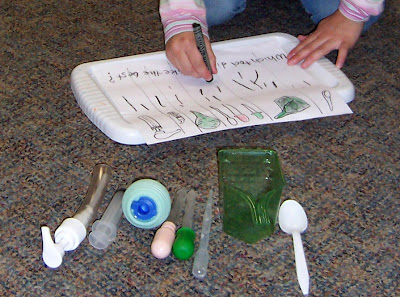
Repeating the activity with an emphasis on measuring would help the children realize that “the most” can be quantified.
What are your ideas for water exploration—indoors and out?
Peggy
I’m looking for ideas on how children can move water in different ways outdoors when the weather warms up. Ideally we’d have a shallow, slow-moving stream of pristine water nearby….
Unforgettable, in every way
By Debra Shapiro
Posted on 2009-03-22
For me, New Orleans will be “unforgettable, in every way,” to quote the old Nat King Cole ballad. I feel as though I left a part of my heart there. It was a privilege to be able to visit the Crescent City, and I thank NSTA for it.
I also will never forget all of the wonderful science educators I met and chatted with each day. Here are six of them who graciously shared their impressions of the conference and allowed me to photograph them.
—Debra Shapiro
 |
Being a [science] coach, I work with a lot of teachers. So from NSTA, I would say that at this conference, I’ve gotten a lot of information for myself as far as professional development with coaching and the different models that different states actually use. So I will take that back and share [it] with the other coaches. Then for teachers, [I’ve received] a lot of hands-on activities that they can use, a lot of information about how to scaffold lessons for English-language-learner students, because we have a big population of those students that we are now learning that we need to service much better.
Charity Lawson, Landover, Maryland |
|
I have been very impressed with the sessions this time. I’ve had a lot of trouble singling out one session for each time slot: I have to narrow it down from about 20.
Mary Lara, Flagstaff, Arizona |

|
 |
This is my first NSTA conference. I’ve heard about them quite a bit; wasn’t quite sure what to expect. It’s been a great experience so far. I attended a lot of workshops based on technology and sort of in that realm, and I learned quite a bit from those…a lot of different project ideas to take back to my classroom…Getting a chance to really learn how to set up a web page and how to have students interact within a web page was wonderful.
Jonathan Ryberg, Astoria, New York |
|
As a person new in a district-wide position, coordinating science education [while] out of the classroom, I approached this conference a little differently than previous ones I’ve come to. I’ve tried to focus on sessions that were more general rather than subject-specific, and so I have been looking for pedagogy and practices and things that make sense in the classroom—best practices in the classroom—and I found a lot of that.
Gary Fortenberry, Lubbock, Texas |
 |
 |
As a [graduate] student, the opportunity to be able to go at a greatly reduced rate was really what spurred me on to be able to go, because otherwise I probably couldn’t have afforded it.
Robin Reiner, Billerica, Massachusetts |
|
I bought some really cool stuff. Lots to see. I drooled over a couple things I’m going to order when I get home, I think. And I got a bunch of things for writing grants and things like that…I teach biotechnology, and there’s tons related to what I teach—that’s even better than what I expected.
Claire Salier-Hellendag, Spring, Texas |
 |
For me, New Orleans will be “unforgettable, in every way,” to quote the old Nat King Cole ballad. I feel as though I left a part of my heart there. It was a privilege to be able to visit the Crescent City, and I thank NSTA for it.
I also will never forget all of the wonderful science educators I met and chatted with each day. Here are six of them who graciously shared their impressions of the conference and allowed me to photograph them.
—Debra Shapiro
Next year in Philadelphia!
Inquiry
By Mary Bigelow
Posted on 2009-03-22
 There were many sessions that focused on promoting inquiry in science teaching. I wish I could have attended all of them, but the ones I could get to had some great ideas. Nancy Chesley and Lynn Farrin from the Main Mathematics and Science Alliance demonstrated the use of probes to determine students conception and misconceptions about a topic prior to the unit.
There were many sessions that focused on promoting inquiry in science teaching. I wish I could have attended all of them, but the ones I could get to had some great ideas. Nancy Chesley and Lynn Farrin from the Main Mathematics and Science Alliance demonstrated the use of probes to determine students conception and misconceptions about a topic prior to the unit. 
Debra Mullinnix from the University of Houston-Downtown shared a template for lesson planning that promotes inquiry.
 And in a different context, Jennifer Berry and Jennifer Perry from Tennessee shared their experiences as teacher-researchers. They participated in summer programs at Vanderbilt University that had classroom teachers serve as research assistants to university professors. They then translated their research into lesson plans for their classrooms.
And in a different context, Jennifer Berry and Jennifer Perry from Tennessee shared their experiences as teacher-researchers. They participated in summer programs at Vanderbilt University that had classroom teachers serve as research assistants to university professors. They then translated their research into lesson plans for their classrooms.
 There were many sessions that focused on promoting inquiry in science teaching. I wish I could have attended all of them, but the ones I could get to had some great ideas. Nancy Chesley and Lynn Farrin from the Main Mathematics and Science Alliance demonstrated the use of probes to determine students conception and misconceptions about a topic prior to the unit.
There were many sessions that focused on promoting inquiry in science teaching. I wish I could have attended all of them, but the ones I could get to had some great ideas. Nancy Chesley and Lynn Farrin from the Main Mathematics and Science Alliance demonstrated the use of probes to determine students conception and misconceptions about a topic prior to the unit.Sunday AM
By Mary Bigelow
Posted on 2009-03-22
 Sunday is a tough day for a presenter. A lot of conference-goers have early departures to get home for class on Monday, many are attending church services, and perhaps a few are recovering from Saturday evening events. But a team from the St. Louis (MO) Public Schools (Nancy M. Williams, Wanicha Disharoon, and Frank Neal) showed us how to take a typical cookbook demonstration and change it into a series of inquiry lessons on Newton’s Laws. They included audience participation and even gave some set-ups away as a door prize!
Sunday is a tough day for a presenter. A lot of conference-goers have early departures to get home for class on Monday, many are attending church services, and perhaps a few are recovering from Saturday evening events. But a team from the St. Louis (MO) Public Schools (Nancy M. Williams, Wanicha Disharoon, and Frank Neal) showed us how to take a typical cookbook demonstration and change it into a series of inquiry lessons on Newton’s Laws. They included audience participation and even gave some set-ups away as a door prize! Sunday is a tough day for a presenter. A lot of conference-goers have early departures to get home for class on Monday, many are attending church services, and perhaps a few are recovering from Saturday evening events. But a team from the St. Louis (MO) Public Schools (Nancy M.
Sunday is a tough day for a presenter. A lot of conference-goers have early departures to get home for class on Monday, many are attending church services, and perhaps a few are recovering from Saturday evening events. But a team from the St. Louis (MO) Public Schools (Nancy M.Switched-on physics
By Mary Bigelow
Posted on 2009-03-22
 My favorite exhibit was Pasadena (TX) Memorial High School’s “Alternative Energy Digital Pipe Organ.” This was a full-size instrument (three keyboards and two octaves of pedals) with the sound of a pipe organ that was built by students at the school. I had a chance to talk with Matt Koby (the chief engineer) who is a senior this year and Mr. Alexander Graham (the physics teacher). We were treated to a concert by organist John Potter, another student who was involved in the project who is now a music major in college. The organ is kept in the physics lab at the school—I want to teach there! For more information, click here for the project website. The project was funded by a Toyota TAPESTRY Grant.
My favorite exhibit was Pasadena (TX) Memorial High School’s “Alternative Energy Digital Pipe Organ.” This was a full-size instrument (three keyboards and two octaves of pedals) with the sound of a pipe organ that was built by students at the school. I had a chance to talk with Matt Koby (the chief engineer) who is a senior this year and Mr. Alexander Graham (the physics teacher). We were treated to a concert by organist John Potter, another student who was involved in the project who is now a music major in college. The organ is kept in the physics lab at the school—I want to teach there! For more information, click here for the project website. The project was funded by a Toyota TAPESTRY Grant. My favorite exhibit was Pasadena (TX) Memorial High School’s “Alternative Energy Digital Pipe Organ.” This was a full-size instrument (three keyboards and two octaves of pedals) with the sound of a pipe organ that was built by students at the school. I had a chance to talk with Matt Koby (the chief engineer) who is a senior this year and Mr. Alexander Graham (the physics teacher).
My favorite exhibit was Pasadena (TX) Memorial High School’s “Alternative Energy Digital Pipe Organ.” This was a full-size instrument (three keyboards and two octaves of pedals) with the sound of a pipe organ that was built by students at the school. I had a chance to talk with Matt Koby (the chief engineer) who is a senior this year and Mr. Alexander Graham (the physics teacher).Secretary of Education addresses NSTA National Conference
By Lynn Petrinjak
Posted on 2009-03-22
 One of the conference highlights was a speech by Secretary of Education Arne Duncan. He gave an inspiring talk on the importance of science and science education. For more information and a video of his speech, go to the NSTA website.
One of the conference highlights was a speech by Secretary of Education Arne Duncan. He gave an inspiring talk on the importance of science and science education. For more information and a video of his speech, go to the NSTA website.Later in the Exhibit Hall, I stopped by the US Department of Education booth. The representative there mentioned that Secretary Duncan stopped by the booth to say hello and to thank them for their participation. She noted that in her experience no other Secretary had done so!
 One of the conference highlights was a speech by Secretary of Education Arne Duncan. He gave an inspiring talk on the importance of science and science education. For more information and a video of his speech, go to the NSTA website.
One of the conference highlights was a speech by Secretary of Education Arne Duncan. He gave an inspiring talk on the importance of science and science education. For more information and a video of his speech, go to the NSTA website.Scenes from the Exhibit Hall
Meet the expert in teaching physics and chemistry cost effectively
By Debra Shapiro
Posted on 2009-03-21
 Ted Koehn of Lincoln East High School in Lincoln, Nebraska, holds a homemade inclined plane he uses in a variety of physics lessons. With humor and insight into teachers’ struggles during this troubled economic time, Koehn told a packed room of budget-conscious teachers how to do more than 60 chemistry and physics labs with low- or no-cost supplies and equipment. |
| While he’s a pro at saving money, he generously provided each attendee with a thick folder filled with instructions for labs and constructing one’s own equipment from such common items as juice cans, old curtain rods, used golf balls, and discarded pieces of wood. For example, he showed how to make a catapult from wood sticks and a plastic spoon. His students use it to launch marshmallows and measure the trajectories. The audience cracked up when he said his students then “eat the marshmallows at their own risk.” Koehn concluded the session by calling the numbers he had written on the teachers’ folders. When a number was called, the lucky teacher could choose which of Koehn’s equipment and supplies he or she could take home. I told Koehn I was impressed by his cleverness in avoiding the need to schlep home all of the materials and by his generosity to his fellow teachers! |
 Francis Ayissi of Washington, D.C., was one of the teachers who was grateful for Koehn’s suggestions. “The value of a workshop like this one will improve the way I’m teaching, and it will also enhance the quality of my labs,” he explained. “In this current economic climate, I believe it’s very, very, very important to see how you can save money by using common materials like those items we find in our homes, kitchens, in the neighborhoods where we live.” |
 Ted Koehn of Lincoln East High School in Lincoln, Nebraska, holds a homemade inclined plane he uses in a variety of physics lessons. Subscribe to |
















